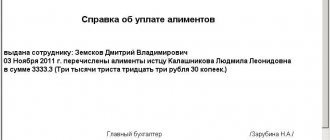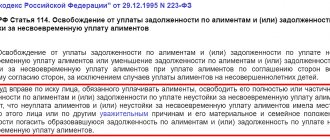Every third recipient of alimony is faced with the problem of debt. It does not matter whether alimony was awarded through the court or voluntarily - every payer can become a debtor.
Calculation of alimony debts is the responsibility of the bailiff conducting a specific proceeding, who must determine the amount of debt in accordance with the law.
If the debtor does not work and is not on the labor exchange, and alimony is collected as a share of income, then the average salary in Russia is taken to calculate the debt.
If alimony was not paid for a good reason, then the amount of the debt may be reduced, and in exceptional cases the alimony may be exempted from paying the debt .
How to calculate alimony arrears
When calculating the amount of alimony debt, you need to take into account several main factors:
- The chosen option for collecting alimony (percentage, fixed amount or hybrid option).
- The absence or presence of any sources of income from the payer, including unofficial ones.
- Living wage in the current region of residence (optional, used only if alimony is calculated based on this living wage).
Revenue share
When the option of assigning alimony in the amount of a percentage of income is used, another important factor becomes the size of the salary or other official income of the defaulter, from which alimony should, in theory, be written off. The higher the income level, the larger the payment and, accordingly, the higher the debt. You should also take into account the percentage of income that is directly related to the number of children the defaulter has:
Articles on the topic (click to view)
- Assignment of the right to claim under alimony obligations is possible
- Formula for calculating penalties and fines for alimony: sample
- What are the consequences of not paying child support in 2020?
- Criminal liability for non-payment of alimony under Art. 157 of the Criminal Code of the Russian Federation
- Is alimony from financial assistance withheld for vacation?
- Find out the debt by name from the bailiffs for alimony
- Reducing alimony debt over the past period
- 1 child: 25% of salary received.
- 2 children: 33% of salary received.
- 3 children or more: 50% of the salary received.
If the debtor does not work
In such a situation, there are several options: working unofficially, receiving unemployment benefits, or deliberately not even trying to look for work.
Regardless of the options, if it is not possible to determine the specific amount of profit received by a person, the only adequate solution is to use the subsistence minimum or minimum wage as the basis (they have become equal since 2020). An exception is made only for those persons who are registered with the employment center. In such a situation, the calculation is made in the same way as described above (percentage of income), but instead of the official salary, the unemployment benefit amount is used.
Conditions for collection and statute of limitations
There is no statute of limitations for overdue alimony debt if it arose through the fault of the debtor. But the debtor has the right to challenge the court decision and provide evidence that debt collection will lead to:
- Violation of his rights.
- Deterioration of financial situation.
The plaintiff can also challenge in court the amount and procedure for receiving debt payments.
The main condition for debt collection is that the plaintiff has material evidence that he made repeated attempts to get the defendant to pay alimony without going to court, but received a categorical refusal. If the parties did not plan in advance to resolve the issue through the court, then most likely no one thought about preparing evidence.
Therefore, if it is impossible to resolve the issue peacefully, you should not immediately go to court. First you need to prepare evidence.
The best way out is to regularly send registered letters to the debtor, which will set out a request for payment of amounts for child support. Failure to respond to letters will be considered by the court as evidence of the defendant’s evasion of financial obligations to the child.
Another option is to collect checks, receipts and invoices that record all expenses for the child, which are made at the expense of one of the parents. For example, the presence of checks confirming that payment for things and other goods for the child was made through the plaintiff’s bank card and the provision of an account statement that will record the sources of funds on the card (among which the defendant will not appear) is suitable evidence for the court .
This is important to know: Average monthly salary for calculating alimony in 2020
The procedure for calculating alimony debt by a bailiff
In the usual case, if the reason for not transferring funds on time and in the required amount is unknown, it is not recommended to contact the bailiffs the very next day after missing the payment deadline. However, if the debt is constantly being formed from month to month, then after 3-4 months you can contact the bailiffs with a clear conscience.
- You need to draw up 2 documents: a statement that alimony has ceased to be received, as well as a statement on the calculation of the debt.
- Documents are submitted to the territorial branch of the SSP.
- The bailiff accepts applications and names the invoice when they are processed.
- Wait for the deadline.
- Receive an already prepared resolution on debt collection. Based on this, further actions are possible, ranging from the calculation of penalties to criminal prosecution.
general information
Article 107 of the Family Code states that the possibility of collecting alimony payments for the past period (up to three years) exists. This event means receiving alimony through the court for the past three years before the actual application, but only on the condition that the applicant had previously tried to take measures to receive these funds, and the second parent simply avoided making such payments.
Moreover, alimony payments within this limitation period can also be recovered in relation to a child who has already reached the age of majority, if the parent previously did not fulfill the obligations of financial support, as evidenced by the evidence presented to the court.
Resolution on calculation of alimony debt (sample)
Features of the resolution on the calculation of alimony debt
After receiving an application from the recipient of alimony, the bailiff is obliged to begin calculating the debt and subsequent execution of the resolution. He has no right to refuse to fulfill his duty, except in cases where the document is drawn up incorrectly or facts with evidence are not provided that could indicate that the truth is actually written in the statement.
This is important to know: Minimum salary for alimony
Statute of limitations
For the court, the reasons why the plaintiff has not previously addressed the issue of forced collection of the resulting debt are not important.
It is important to provide the court with evidence that officially confirms attempts to independently obtain funds from the defendant for child support. This will help prove the defendant’s evasion of alimony payments.
Even after the child reaches 18 years of age, the plaintiff (one of the parents or official guardian) has every right, within a 3-year period to collect the resulting debt for payments of funds for the maintenance of the minor.
This applies to statutes of limitations, and arrears recognized by the court for alimony must be paid in full by the defendant.
Cancellation of alimony debt
Article 114 of the RF IC provides for the possibility of canceling the debt that has arisen in whole or in part, but this is only possible if there are really very good reasons for this, which the debtor can document. Such circumstances include:
- Dismissal due to reduction. In this case, the payer is not to blame for the current circumstances and may be granted a deferment of alimony payments for a period of 2 months. It is assumed that during this period the person must either find another job or register with the employment center. In any case, this is only a short-term debt cancellation.
- If the transfer of alimony did not occur for reasons unrelated to the payer. The accounting department could have made a mistake, the recipient provided the wrong account, technical problems at the bank and other similar situations fall under this category and exclude the possibility of debt formation.
- A sharp deterioration in the debtor’s well-being due to reasons beyond his control (terrorist acts, natural disasters, and so on). It is quite logical that a person first needs to deal with the problems that have arisen and only then continue to pay alimony.
- Serious illness of the defaulter or his immediate relatives. In such a situation, all available funds are spent on treatment and the court does not yet have the right to determine the amount of debt, because it is not the payer’s fault.
FREE CONSULTATIONS are available for you! If you want to solve exactly your problem, then
:
- describe your situation to a lawyer in an online chat;
- write a question in the form below;
General information
Payment of alimony is carried out according to a standard procedure, so the period and amount must be established. And if the payer violates these conditions, a debt arises. Russian legislation provides for certain liability for alimony debt. And first of all, this is the collection of penalties.
You can collect debt and penalties (in the amount of 0.5% of the amount for each day) through bailiffs. But first you need to calculate the debt. To do this, the recipient of alimony must submit a corresponding application to the FSSP.
The collection procedure consists of the following stages:
- Contacting the bailiffs to obtain information about the debt.
- Calculation of penalties.
- Going to court.
- Receiving a new writ of execution.
The bailiff does not calculate the penalty, since this is not his responsibility. He can only provide the necessary information about the debt.
Collection of alimony for the past period
The possibility of collecting alimony for past periods is often a way for the plaintiff to solve his financial problems at the expense of the defendant. For this reason, the law establishes clear deadlines for which payments may be collected from the debtor. In this case, the plaintiff must provide a certain set of documents and evidence indicating the fact of the defendant’s evasion of his duties.
An important condition for filing such a claim is the absence of a voluntary agreement between the parties concluded before going to court.
Appeal to the bailiffs
According to Federal Law No. 229, the alimony claimant has access to all documents related to a specific enforcement proceeding. This also applies to debt formation. To obtain information, you must submit an application in simple written form:
- Name of the corresponding territorial branch of the FSSP.
- Personal data.
- Payer information.
- Information about enforcement proceedings. The details of the relevant document (this could be an agreement), as well as the amount and method of payment, are indicated.
- The date from which the payer began to delay payments.
- Please recalculate the debt.
- List of documents.
- Date, signature.
(name of bailiff service)
(full name, address, telephone)
STATEMENT
on calculating arrears of alimony
“___”_________ ____ the bailiff ____________ (full name of the bailiff, name of the division of the bailiff service) initiated enforcement proceedings to collect alimony from ____________ (full name of the debtor) in favor of ____________ (full name of the claimant) for the maintenance of ____________ (full name of the person , for whose maintenance alimony must be paid).
The last time alimony was paid was “___”_________ ____, after that payment was not made because ____________ (indicate the reasons why alimony was not paid).
It is necessary to determine the amount of alimony debt, since ____________ (indicate why it is necessary to determine the amount of debt) for the period from “___”_________ ____ to “___”_________ ____.
Based on the above, guided by Articles 64.1, 102 of the Federal Law “On Enforcement Proceedings”, Article 113 of the Family Code of the Russian Federation,
Ask:
Determine the amount of alimony debt ____________ (full name of the debtor) in enforcement proceedings for the collection of alimony from ____________ (full name of the debtor) in favor of ____________ (full name of the claimant) for the maintenance of ____________ (full name of the person for whose maintenance alimony must be paid) for the period from “___”_________ ____ to "___"_________ ____
This is important to know: Application for voluntary payment of alimony: sample
List of documents attached to the application:
Documents confirming the existence of grounds for calculating alimony debt (if the applicant has such documents)
Date of application “___”_________ ____ Signature _______
Some documents must be attached to the application - a passport, a writ of execution or an agreement, etc. After the official receives the application, he must provide the necessary information to the claimant within 1 month.
First, the bailiff calculates the amount of debt based on the data received. Then he makes the appropriate decision. Based on this document, the applicant calculates the penalty. Such a calculation can be made with the help of a lawyer and recorded in the form of a separate document or indicate the necessary information in the statement of claim.
A creditor who wants to collect a debt and a penalty must necessarily go to court. But this does not always guarantee payment of funds by the defendant. For example, if the payer’s location is unknown or he does not have the funds to repay the debt, the property will have to be seized.
Features of collecting alimony for the past period
If one of the child’s parents evades his obligation to support him, the second parent has the right to go to court to demand forced collection of alimony for the minor.
According to the provisions of Article 107 of the Family Code, the assignment of alimony is possible only from the date of filing the statement of claim with the judicial authority. But since the need for funds for the child arises from the claimant before the start of legal proceedings, a reasonable question arises: is it possible to collect alimony for the past period.
Let's sum it up
A payer who does not repay the alimony debt even on the basis of a court decision must be prepared for the following consequences:
- Accrual of additional fines.
- Involvement in forced labor.
- Ban on traveling abroad and driving.
- To criminal liability (including a term of imprisonment for 1 year).
- Deprivation of parental rights.
Child support arrears can easily lead to a huge number of problems. Especially if the payer’s intent is proven. Then, in addition to the penalty, you will have to pay additional administrative fines, agree to the seizure and further sale of property, etc. In some cases, a willful defaulter may be subject to deprivation of the right to drive a car or deprivation of parental rights.
If you want to find out how to solve your particular problem, please use the online consultant form below or call :
(for residents of St. Petersburg and the region)








